|
Twin Hornets at High Noon by Tim "Flyboy" Henderson with Leonard "Viking1" Hjalmarson |
||||
|
The MFD from DIs sim looks extremely good. In fact, it is practically a photograph from an actual FA 18E cockpit. Functionally there are only small differences in these two, but some are going to prefer the photo realism of DIs cockpit to Jane's virtual cockpit. One of the functional differences is that ALL the knobs that would work in the real Hornet work on DI's MFDs. For example, the brightness and contrast knobs at each corner are actually functional and you could vary the brightness on each MFD if you chose.
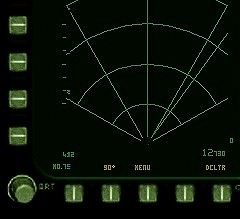 DI Radar. Brightness Knob lower left. There are a few more differences in the modeling of the AT FLIR, however. Let's compare screens from both sims and take a look. First, let's look at the MFD in DI's Super Hornet simulation. 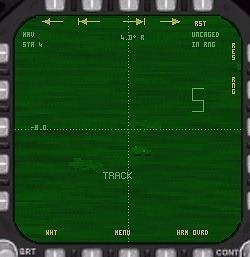 DI's FLIR Again, the photo realistic cockpit makes this a very nice looking MFD indeed. But more important to some, there are a couple of additional function keys provided. Notice the ALG function second button from the left at bottom. And notice the STBY designation at top left. 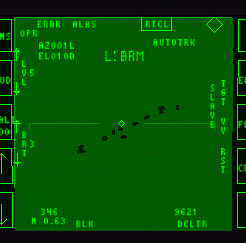 Jane's AT FLIR Viking1: In Jane's the AT FLIR appears to have only two modes: ON and OFF, with STANDBY avoided for simplicity. There is also a note in the DI manual that moving from OFF to STBY will require a five second delay while the gyros spin up. Personally, I have no problem with simplifying some of these things. A strict comparison of obsessive tendencies on the part of designers would have to give the nod to DI in the functionality department. If you happen to have worked on these aircraft and spent a lot of time in the cockpit, it might matter to you. Otherwise... |
Considering the total package, pure avionics detail, JFA wins. This becomes even more apparent when you look at other systems modeling, like the HARM and HARPOON systems.
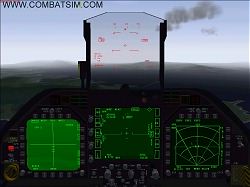 Custom Arming Screen In the above image I have gone to A2G mode, reflected by the change in the right MFD with ground radar now on. The Advanced Targetting FLIR has now been selected in the Up Front Controller. The A/GATFLIR consists of four pointing modes in addition to an Autotrack mode. The target designation laser is also part of the ATFLIR pod, and is always slaved to the current FLIR image.
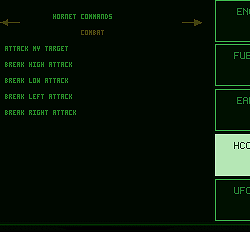 DI HCOM The four pointing modes are divided evenly between ground and aircraft stabilization. A gound stabilized display means that the ATFLIR pod tries to remain pointing at the same spot on the ground regardless of aircraft motion. An aircraft stabilized display maintains the current azimuth and elevation settings for the pod while the aircraft manouvers (also called a "snowplow" mode). Or suppose you want to lase the target for your wingman or your buddy in multiplayer mode? You can't do this in DISH. Or what if you would prefer to program your HARPOON for high flight and then sea-skimming near the target? Sorry, only JFA allows this much flexibility. Does this mean JFA is absolutely exhaustive? No. For example, the real F/A 18 actually displays RWR info in the HUD, but Jane's does not model this for the sake of reducing clutter. DI, on the other hand, chose to model this feature. Physics, Environment Tim: For JFA factor in a moving and pitching carrier deck, and real time weather. I've flown some single missions three times and had different weather to contend with each time. And sitting on the CAT while the deck pitches around.. impressive! Likewise the clouds in JFA are slightly better than those in DISH. But overall, the lighting in DISH is excellent, especially on the carrier deck at night. Oddly, the two sims differ in their modeling of night vision gear. While JFA models night vision via FLIR projection on the HUD alone, DISH offers the typical night vision goggles. We're not sure what is up with the difference, though we suspect that the USN doesn't use NV goggles in the FA-18E. Physics in general are better in JFA. You will see your wheels turn and the gear compress when you land. JFA also models the actual wires for carrier landing physics, making the touchdown a bit more interesting. GO to Part V.
|
|||
|
Copyright © 1997 - 2000 COMBATSIM.COM, INC. All Rights Reserved. Last Updated January 12th, 2000 |
||||
